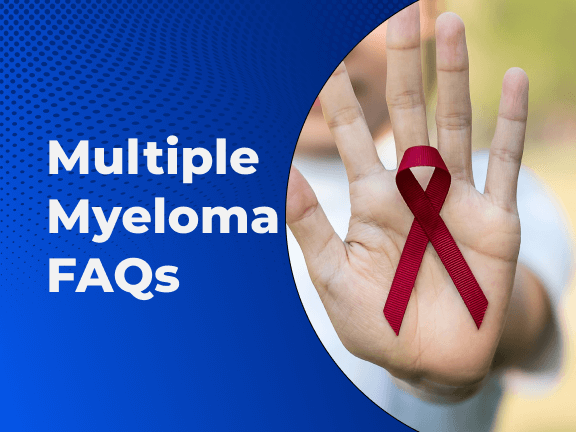Multiple Myeloma Frequently Asked Questions
Multiple Myeloma, also known as myeloma, is an uncommon type of bone marrow cancer with a rate of 0.76 percent in the United States. Although rare in the general population, it is the most common type of plasma cell cancer. In this article, we will answer questions and provide information on many aspects of this disease.
What is Multiple Myeloma?
Multiple myeloma is a type of bone marrow cancer. On some sources, it may also be defined as plasma cell cancer. That is also a correct classification because plasma cells are found in the bone marrow, the spongy tissue inside the bone.
The plasma cells function as a vital part of the immune system as they are responsible for producing the antibodies that fight infections. When the plasma cells start to change and populate uncontrollably, myeloma begins. The overpopulated plasma cells (called the myeloma cells) take over the healthy cells in the bones and create lesions (and sometimes structural damage such as fractured or broken bones). These lesions may also appear on other parts of the body such as the spine, pelvis, skull, and ribs. That is why the disease is called multiple myeloma.
When the bone marrow is infested with myeloma cells, the other types of blood cells located in the bone marrow, which are red blood cells, white blood cells and platelets are suppressed, and the creation of healthy plasma cells are slowed, which eventually has systemic effects on the patient’s immunity.
Let’s explain how. The red and white blood cells, as part of the immune system, are defense agents against infections and other diseases just like the plasma cells.
- White blood cells: The type of white blood cells that is relevant here is the lymphocytes (lymph cells), which include B cells. In case of an infection, the B cells mature and turn into plasma cells, creating an antibody called immunoglobulin and helping the fight. When the number of healthy blood cells is down because of the suppression caused by the myeloma cells, the immune system’s ability to fight infections and diseases is reduced considerably.
- Red blood cells: The red blood cells contain hemoglobin which carries oxygen through the body from the lungs. When the number of healthy red blood cells is reduced, not enough oxygen is circulated in the blood, resulting in anemia. Anemia causes conditions such as fatigue, weakness, shortness of breath, and rapid heartbeat. It is one of the most prominent symptoms of multiple myeloma.
- Platelets: The platelets are the smallest type of blood cells that recognize the damaged tissue and repair it by binding together. When the myeloma cells cause a platelet shortage, the blood is unable to clot in case of bleeding or repair the injury, thus leaving the body exposed to infections.
In addition to preventing the healthy blood cells from functioning, the myeloma cells keep producing antibodies, called the monoclonal protein (or monoclonal immunoglobulin, or M protein). These antibodies’ main difference from the ones produced by healthy plasma cells (polyclonal protein) is their inability to fight the infections properly. The excessive amount of M protein created by the myeloma cells not only reduces immunity but can also cause kidney and other organ damage by building up in the blood and urine.
Before moving to the risk factors for multiple myeloma, let’s go over the other plasma cell disorders briefly.
Monoclonal gammopathy: It is the condition where there are abnormal proteins in the blood with abnormal amounts, due to the excessive amount of plasma cells. Monoclonal gammopathy is seen not in multiple myeloma patients but also in patients who suffer from diseases such as some types of lymphoma and Waldenstrom macroglobulinemia. There is also another condition called monoclonal gammopathy of undetermined significance (MGUS). Since it is not as problematic as multiple myeloma and not classified as cancer, it is not treated right away but watched instead. However, the likelihood of patients with MGUS’s developing multiple myeloma or another disease should not be overlooked.
Solitary plasmacytomas: Plasmacytoma is cancerous plasma cell growth. It is named solitary plasmacytoma because, unlike multiple myeloma, growth occurs in one tumor only, often located in the bones. The most common treatment is radiation therapy, and occasionally surgery. The likelihood of developing multiple myeloma of patients with solitary plasmacytomas is high, so they are watched closely. If it spreads to another tissue, it is given the name extramedullary or extraosseous plasmacytoma.
Smoldering multiple myeloma (SMM): It is asymptomatic or early-stage myeloma. Since it can stay as it is for months or years, the treatment does not start right away. Some patients’ conditions may never turn into symptomatic myeloma. SMM is an intensely researched field. Although SMM patients’ blood counts, calcium levels, and kidney functions are normal, and they do not have bone or organ damage or signs of amyloidosis, they present some similar signs as multiple myeloma patients.
- High level of plasma cells in the bone marrow
- High level of monoclonal immunoglobulin in the blood
- High level of light chains in the urine
Light chain amyloidosis: Light chain amyloidosis, also known as AL or primary amyloidosis, is a protein misfolding disorder. The amount of abnormal plasma cells in bone marrow is lower than the ones in multiple myeloma. The monoclonal proteins created by the plasma cells consist of banded protein chains called light chains and heavy chains, two for each. The light chains are shorter and lighter than heavy chains. When the number of light chains is more in numbers than heavy chains, light chain amyloidosis occurs. In this case, the light chains accumulate in tissues and form amyloid. The amyloid accumulation might cause various problems in various organs, such as heart enlargement or irregular heartbeats, kidney dysfunction, or failure.
Waldenstrom macroglobulinemia (WM): WM cells produce a huge number of antibodies called immunoglobulin M (or IgM in short), also known as macroglobulin. The cells share features both with multiple myeloma and non-Hodgkin’s lymphoma. When the protein WM cells produce accumulates in the body it causes complications such as nervous system, sight or excess bleeding problems.
Is Multiple Myeloma a Form of Leukemia?
Both multiple myeloma and leukemia are types of blood cancers. Multiple myeloma is where a very high number of plasma cells are produced in the bone marrow, which eventually leads to tumors. On the other hand, leukemia usually evolves around white blood cells. Multiple myeloma survivors are at a high risk of developing acute myeloid leukemia, which starts first in the bone marrow and rapidly spreads to the blood.
What Are the Risk Factors for Multiple Myeloma?
It is still unknown what causes multiple myeloma, but some risk factors have been identified.
Age: The risk of having multiple myeloma increases as the person ages. Although the average age of diagnosis is 70, it is most common among people over 60. Patients diagnosed with multiple myeloma under 40 make up only 2 percent of all cases.
Sex: Males are 1.5 percent more likely to develop multiple myeloma than females.
Race: The disease is twice more common among African descents than white.
Family history: Having first-degree relatives (parents, siblings, and children) with multiple myeloma increases a person’s likelihood to develop the disease by 2 to 3-fold.
Medical history: The history of solitary plasmacytoma of bone or monoclonal gammopathy of undetermined significance (MGUS) creates a greater risk of developing multiple myeloma.
Overall health: Obesity increases the risk of developing multiple myeloma.
Exposure to chemicals and radiation: Exposure to certain chemicals such as asbestos, pesticides, benzene, and some others used in rubber manufacturing might increase the risk of developing multiple myeloma. In addition, exposure to some products used in carpentering, furniture making, and paper making are included in this list. Firefighters and other professionals who are exposed to herbicides, including Agent Orange, are also at higher risk of developing multiple myeloma. Exposure to radiation also poses risk.
What Are the Symptoms and Signs of Multiple Myeloma?
Early diagnosis is very important in multiple myeloma. It is a disease that sometimes might advance without presenting any symptoms or signs, or with symptoms and signs that can indicate some other disease. On the other hand, some patients experience the below listed:
Low blood counts: As the plasma cells dominate the blood cell population, a shortage of red blood cells, white blood cells and platelets occurs, and causes different problems with different effects.
- Anemia: Shortage of red blood cells causes weakness, fatigue, dizziness, and shortness of breath.
- Leukopenia: Shortage of white blood cells leads to a weaker immunity, thus more frequent infections.
- Thrombocytopenia: Shortage of platelets causes inability of clotting of blood and repairing bruises.
Hypercalcemia: Shows elevated levels of calcium in the blood. When bones leak calcium, it accumulates in the blood and causes different effects such as vomiting, abdominal pain, upset stomach, constipation, frequent urination, extreme thirst, nausea, and loss of appetite. When the amount of calcium in the blood reaches extremely high levels, it can even force the patient into a coma.
Kidney failure: The high amount of M proteins resulting from the multiple myeloma may cause kidney failure or damage. Its symptoms include swollen ankles, legs and feet, shortness of breath, fatigue and drowsiness, nausea, confusion, chest pain, reduced amount of urine, seizures and coma.
Bone damage: The lesions appearing on the bones might cause fractures and breaks. Local or overall (osteoporosis) bone weakness is also common. They also cause bone pain, especially in the pelvis, ribs, back, and skull.
Does Multiple Myeloma Run in Family?
Multiple myeloma has both genetic and hereditary elements. People with parents, siblings, and children with multiple myeloma carry the risk of developing multiple myeloma 2 to 3 times more than those who do not have such relatives.
How is Multiple Myeloma Diagnosed?
There is not just one method to diagnose multiple myeloma. Medical professionals consider various factors before deciding on which diagnostic methods they will proceed with. These factors include the patient’s medical history, age, general health condition, the signs and symptoms they present, and the type of cancer the doctor suspects. In a large majority of multiple myeloma cases, the patients diagnosed do not present any symptoms related to the disease, but the existence of the disease is confirmed through tests intended for something else.
The tests used to diagnose multiple myeloma can be classified into three categories: laboratory tests, imaging tests, and biopsies.
Laboratory tests: Testing blood, urine, and other tests is an effective method in diagnosing multiple myeloma since it will reveal any fundamental changes that indicate the existence and the stage of the disease.
- Blood counts: A complete blood count (CBC) explores the levels of three types of blood cells: red blood cells, white blood cells, and platelets. The shortage of these tree types might be evidence of high levels of plasma cells, which indicates multiple myeloma.
- Blood chemistry tests: Level of kidney functionality is checked through the creatinine levels. Multiple myeloma patients commonly have high levels of creatinine. The level of albumin is also checked since low levels might hint the disease. Calcium levels are also checked since high levels of calcium (hypercalcemia) are common among patients with advanced multiple myeloma. Another search is for lactic dehydrogenase (LDH). The higher the level of LDH, the more advanced the stage.
- Serum free light chains: The usual ratio of two kinds of light chains in blood is 1 to 1. This test measures the ratio in the absence identified M proteins in case of a suspicion. Any ratio other than the usual, combined with other factors, might be interpreted as an indicator of multiple myeloma.
- Quantitative immunoglobulins: The levels of various antibodies called immunoglobulins, namely IgA, IgD, IgE, IgG, and IgM, are separately measured. In multiple myeloma, the level of cancer protein is higher than the level of normal immunoglobulins.
- Beta-2 microglobulin: High levels of this protein, created by the myeloma cells, help doctors identify the stage of the disease.
- Electrophoresis: In healthy cell production, created antibodies are not the same. However, when myeloma cells create antibodies, they are exactly the same (monoclonal). Since the existence of monoclonal antibodies will hint the multiple myeloma, a test called serum protein electrophoresis (SPEP) is done to explore if the antibodies in the blood are so. The antibodies searched go by different names such as monoclonal immunoglobulin, monoclonal protein (M protein), M spike, or paraprotein.
- Urine test: In the urine protein electrophoresis (UPEP) the urine sample is investigated to see if there are any myeloma proteins (M protein). The patients might also be prescribed an additional test called urine immunofixation and collect urine samples for a period of 24 hours to identify the level of M protein.
Imaging tests: Doctors refer to imaging tests for various reasons, such as to see if the bones are damaged by multiple myeloma, if any part of the body has cancer, how outspread the cancer is, and if the planned treatment is working or not.
- X-ray: Used to check if the bones are damaged by multiple myeloma. During x-ray (also called a bone survey or skeletal survey), the patient is exposed to a small amount of radiation to have pictures of inside their body.
- CT (computed tomography) Scan: The x-rays are combined by a computer to form a detailed image of the scanned organs.
- MRI (magnetic resonance imaging) scan: Usually preferred to have images of bones, the brain, and the spinal cord, the MRI uses radio waves and strong magnets to get images. To get better results, gadolinium (a contrast material) might be injected into veins before scanning. It also helps create images of plasmacytomas and bone marrow. That is why it is preferred when the patient has bone pain, but the x-ray does not provide helpful data.
- PET (positron emission tomography) scan: The patient is injected with a form of radioactive sugar through the veins. The cancerous cells absorb the sugar, and the camera can spot the areas of body, where the amount of sugar is concentrated. Like MRI scan, it can locate the plasmacytomas, so it is preferred when the patient has bone pain, but the x-ray does not provide enough to identify why.
- ECHO (echocardiogram): An ECHO is consulted when the medical team suspects amyloidosis in the patient. As this condition affects the heart, they scan the organ with an ultrasound to see how well it functions. The muscles affected by amyloidosis look different and damage healthy pumping function. So, along with the size of the hearth the state of muscles and pumping are also checked.
Biopsy: It is a medical procedure to collect tissue from the body to examine under the microscope.
- Bone marrow biopsy: The bone marrow consists of two different types of tissues subject to biopsy: solid tissue and liquid tissue. The process of liquid tissue collection and examination is also called bone marrow aspiration. The samples are usually collected from the pelvic bone, and with a needle. The pathology lab follows several procedures to find out if there are any cancerous cells in the bone marrow, and their size, shape, and arrangement. These procedures include immunohistochemistry and flow cytometry, and chromosome analysis.
- Fat pad aspirate: When M proteins accumulate in some organs, they cause misfunction or malfunction. The term used for this situation is amyloidosis. When amyloidosis is suspected, a sample is collected from the abdominal fat pad to be examined.
- Biomarker testing: The samples collected from the bone marrow and/or the tumor are tested for specific chromosomes, genes, proteins, and other elements related to cancer growth. The information gathered through the tests is vital for determining the treatment options. That is why there are various procedures in biomarker testing. The first one is cytogenetics, a test that aims to identify the genetic mutations and the level of aggressiveness of cancer. The second is fluorescent in situ hybridization (FISH), the test focusing on genetic changes, using a fluorescent dye. The last one is called the minimal residual disease (MRD) test, which aims to find if any traces of the disease are left, even the smallest amounts, after the treatment. When the patient is MRD positive, meaning there is a small amount that should be addressed before it spreads.
Multiple Myeloma Progresses Through How Many Stages?
Staging helps the medical team choose the best treatment option for the patients and anticipate the prognosis. There is not just one method of staging that applies to all types of cancer. For multiple myeloma, the patients are generally classified into two, based on the presence of their symptoms:
Asymptomatic multiple myeloma patients do not experience any symptoms and signs; thus, they are watched closely without being treated. However, in some cases, some therapies can be followed to stop the possible growth or spread of the disease.
Symptomatic multiple myeloma patients experience symptoms and signs and need treatment. The common acronym used for multiple myeloma symptoms is “CRAB”, created by the initials of calcium, renal, anemia, and bone. Having one or more symptoms included in the CRAB indicates the need for treatment. In addition to CRAB symptoms, amyloidosis, hyperviscosity (blood thickening), and repeated bacterial infections (more than twice a year) are symptoms that require treatment.
Apart from the CRAB symptoms, some other conditions also indicate the need for treatment:
- Level of plasma cells in the bone marrow over 60 percent
- A ratio of light chain that is above or below 1
- Identified bone lesions through MRI or PET/CT scan
Another method used for staging multiple myeloma patients is called the Revised International Staging System (RISS). The system is based on the global data collected from multiple myeloma patients and defines the 3 stages according to factors that affect the survival of the patient. The data to define the limits of stages are acquired through measurements of serum albumin, LDH and serum beta-2-microglobulin, along with the existence of high-risk chromosomes identified with FISH test.
There is also another system of staging for multiple myeloma called the Durie-Salmon Staging System, based on the levels of M protein, calcium, red blood cells and the degree of bone damage. Like the RISS system, there are also 3 stages defined.
How is the Prognosis Determined for a Patient with Multiple Myeloma?
The prognosis is the chance of recovery or recurrence, which is usually determined based on the stage of the disease. For multiple myeloma, the 5-year survival rate is 50.7 percent. This low rate is due to the late diagnosis of the disease. For an early-stage diagnosis, the 5-year survival rate is 71 percent. When diagnosed later, and cancer has spread to distant parts of the body, the 5-year survival rate drops to 48 percent.
Based on the stages, the patients are estimated to live for the below-given period in average:
- Stage I: 62 months (5 years, 2 months)
- Stage II: 44 months (3 years, 8 months)
- Stage III: 29 months (2 years, 5 months)
There are additional factors that affect the prognosis of multiple myeloma:
- Age: The RISS data shows that the older the patient, the lower the chance of recovery.
- Kidney function: The malfunctioning kidneys become incapable of eliminating the chemical from the body. This diminishes the chances of recovery.
- Overall health: Some health problems such as heart disease, diabetes, or obesity might predict a negative prognosis.
Is Multiple Myeloma a Fatal Disease?
The mortality rate of multiple myeloma was high in the past. However, cancer research is advancing faster than ever. The new drugs and therapies help patients live longer periods of time. The younger and in earlier-stages they are diagnosed, the longer they live. A cure for the disease has not been found yet but managing it is possible.
What Are Popular Treatments for Multiple Myeloma?
In case of asymptomatic or smoldering myeloma, treatment is not needed right away. The medical team closely watches the patient through regular visits and tests, monitors the status and acts when needed.
If and when patients start to present symptoms and signs, treatment starts. It is usually designed by a group of doctors from different fields of medicine to craft the best possible option. The main goals in treatment can be listed as defeating the myeloma cells, taking the cancerous cell growth under control, managing the pain and increasing the patient’s quality of life. It should be noted at this point that there is no cure for multiple myeloma but treatment options that increase the patient’s quality of life and help manage symptoms.
American Cancer Society categorizes the treatment options as local and systemic.
Local treatment options: This category includes surgery and radiation therapy as treatment, where the aim is to treat the local part of the body where the cancer is located. These options are usually followed for early-stage patients.
Systemic treatment options: The options in this category include drug therapies, transplants and supportive treatments, where the whole body is affected by the application.
- Drug therapies include chemotherapy, immunomodulating agents, monoclonal antibodies, corticosteroids, bisphosphonates for bone disease, proteasome inhibitors, nuclear export inhibitors, antibody-drug conjugates, and drug combinations
- Stem cell transplant is the most common treatment option for multiple myeloma. When this method first started being used, the stem cells were collected from the bone marrow, that is why it used to be known as bone marrow transplant. With the development of new techniques, stem cells are now collected from the blood. First, the patient is given chemotherapy to kill the cancerous cells, and then the transplant is performed. The stem cell transplant has two types based on the source of the cells: autologous and allogeneic. In autologous transplant, the patient’s own stem cells are collected and stored to be sued when needed. It can be advised to have two autologous transplants 6 to 12 months apart, which is called a tandem transplant. Although it presents severe side effects, it is a common treatment among multiple myeloma patients. Allogeneic transplants use stem cells collected from a matching donor. Although it entails more risk than autologous transplant, it also presents a stronger chance to defeat the tumor. The risk taken here is called graph vs tumor effect.
- CAR T-cell therapy is short for chimeric antigen receptor therapy and type of cancer immunotherapy. Basically, it strengthens the immune cells by changing some genes inside, and thus, sometimes called the cell-based therapy. Cells collected from the patient, the T cells inside them are altered in the lab with specific proteins that can attack cancer cells and returned to the patient’s body to fight the tumor. The cellular immunotherapies approved to treat multiple myeloma are idecabtagene vicleucel (Abecma) and ciltacabtagene autoleucel (Carvykti).
- Supportive treatment aims to ease or prevent the symptoms rather than cure the diseases. In multiple myeloma cases, patients are given antibodies called intravenous immunoglobulin (IVIG) (either from the patient or a donor) to strengthen the immune system. For multiple myeloma patients suffering from anemia, blood transfusion is a good solution to get rid of the side effects such as fatigue or shortness of breath. For anemic patients receiving chemotherapy, drugs called Epoetin (Procrit) and darbepoetin (Aranesp) are also used for the same purpose. For multiple myeloma patients suffering from blood thickness, a procedure called plasmapheresis is performed to thin out the blood and increase circulation.
Are There any Multiple Myeloma Clinical Trials?
Scientists are constantly working to develop new ways to treat patients, create new drug combinations or therapies and even cure multiple myeloma. According to the US National Library of Medicine, there are currently about a thousand clinical trials in different phases and statuses all over the world focusing on multiple myeloma. Clinical trials offer patients innovative treatment options that are not yet available, often for free. At Massive Bio, we created a system and a brand-new platform where we match cancer patients, including the ones suffering from multiple myeloma to suitable trials anywhere in the world. Feel free to get a free consultation, or explore clinical trial options.
Can Stress Cause Multiple Myeloma?
Stress itself does not directly cause any type of cancer. But since it weakens the immune system, the body’s defense against infections and diseases diminishes. And as multiple myeloma is deeply related to the immune system, patients are deeply affected by stress. As with all types of cancer, the stress hormone called noradrenaline gives rise to the growth of cancer cells.
Can You Live a Normal Life with Multiple Myeloma?
The patients’ quality of life is their overall joy of life and includes domains such as physical, psychological, social, and financial activities. There is no cure for multiple myeloma yet and patients live with the disease for the rest of their lives. It affects multiple parts of the body, leading to various problems, mainly bone or kidney problems. The treatments focus on reducing the symptoms so that patients can lead better lives. The health problems patients experience physically also affect other domains inevitably. That is why it is important both for patients and their caregivers to have a clear understanding of living with and managing multiple myeloma.
Sources:












